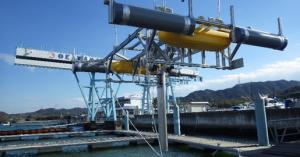Okayama University Research: Innovative pendulum-dynamo for generating electricity from tidal energy

Pendulum power: Innovative pendulum-dynamo for converting tidal energy into electrical power
Okayama University's Shinji Hiejima is looking for industrial partners to commercialize his experimentally proven and patented concept of the Hydro-VENUS system for converting tidal energy into electrical power. Research on converting tidal energy into electricity energy has a long history with the European Marine Energy Centre, in Scotland being one of the major international hubs for testing ideas on extracting energy from the motion of seas and tidal currents.
In Japan the search for energy resources is a high priority with research on exploiting the power of the seas surrounding the Japanese archipelago being actively pursued. Notably, a report published by New Energy and Industrial Technology Development Organization (NEDO) in 2010 states that the potential of tidal energy in Japan is equivalent to 20 nuclear power plants. Furthermore, the Seto Inland Sea—where Okayama University is located—has been assessed as being a site with especially high potential.
Research highlights
Plant science: Plant models for crop breeding of the future
This review article summarizes the structure and stability of all the minichromosomes that Minoru Murata and colleagues at Okayama University have isolated since 2006, and describes their interesting features.
Photosynthesis: New model of the quality control of Photosystem II
M. Y.-Nishimura and Y. Yamamoto at Okayama University proposed the new model of the quality control of PSII focused on the structure of thylakoid membranes.
Repairing DNA lesion
Repair of DNA lesion is essential for mammalian development. Notably, DNA lesions in cells caused by genotoxic agents results in arrest of cell cycle and ultimately in cell death. In response, DNA polymerase ζ (Polζ) is a translesion DNA polymerases that repair DNA damage and relieve cell cycle arrest.
Bacterial Nanometric Amorphous Fe-Based Oxide: Potential of Lithium-Ion Battery Anode Material
Leptothrix ochracea is a species of iron-oxidizing bacteria that exists in natural hydrospheres where groundwater outwells worldwide. Intriguingly, the bacterium produces Fe3+-based amorphous oxide particles that readily assemble into microtubular sheaths encompassing the bacterial cell. The mass of such sheaths (named L-BIOX : Biogenous Iron Oxide produced by Leptothrix) has been usually regarded as useless waste, but Jun Takada and colleagues at Okayama University discovered unexpected industrial functions of L-BIOX such as a great potential as an anode material in lithium-ion battery.
INTELLECTUAL PROPERTY AND ENTERPRISE
Synthesis of novel homeostasis modulators by “Westernized Kampo Medicine”
—Retinoid X Receptor Partial-Agonists Exert Anti-type 2 Diabetes Effects with Less Adverse Effects than Full-Agonists—
http://www.okayama-u.ac.jp/user/kouhou/ebulletin/ipe/vol7/ipe_001.html
“Westernized Kampo Medicine” is a novel approach in modern medicine, defined by Dr. Hiroki Kakuta, that intends to exhibit the effects of Japanese Kampo Medicine with small molecules (Ref. 1). Japanese Kampo Medicine was developed in Japan, branching from traditional Chinese Medicine (Oriental Medicine). In contrast to Western Medicine, which has a well-regarded therapeutic method of treating diseases by using drugs focused on target molecules such as receptors or enzymes specifically related to each disease, Oriental Medicine is a systematic treatment based on consideration of a patient's homeostatic condition and environmental factors to determine a patient's well-being. In particular, Chinese herbs are one of the tools used for treatments in Oriental Medicine. Recent common diseases such as diabetes, Alzheimer's Disease, and cancer are considered to be closely related to patients' life styles, and are expected to be diagnosed and be treated by “Westernized Kampo Medicine”.
Further information
Okayama University
1-1-1 Tsushima-naka , Kita-ku ,
Okayama 700-8530, Japan
Planning and Public Information Division, Okayama University
E-mail: www-adm@adm.okayama-u.ac.jp
Website: http://www.okayama-u.ac.jp/index_e.html
About Okayama University
Okayama University is one of the largest comprehensive universities in Japan with roots going back to the Medical Training Place sponsored by the Lord of Okayama and established in 1870. Now with 1,300 faculty and 14,000 students, the University offers courses in specialties ranging from medicine and pharmacy to humanities and physical sciences. Okayama University is located in the heart of Japan approximately 3 hours west of Tokyo by Shinkansen.
Website: http://www.okayama-u.ac.jp/index_e.html
This research is featured in the June 2014 issue of the Okayama University eBulletin: http://www.okayama-u.ac.jp/user/kouhou/ebulletin/
Source: Okayama University, Planning and Public Information Division
Associated links
Media Contact
All latest news from the category: Power and Electrical Engineering
This topic covers issues related to energy generation, conversion, transportation and consumption and how the industry is addressing the challenge of energy efficiency in general.
innovations-report provides in-depth and informative reports and articles on subjects ranging from wind energy, fuel cell technology, solar energy, geothermal energy, petroleum, gas, nuclear engineering, alternative energy and energy efficiency to fusion, hydrogen and superconductor technologies.
Newest articles

Bringing bio-inspired robots to life
Nebraska researcher Eric Markvicka gets NSF CAREER Award to pursue manufacture of novel materials for soft robotics and stretchable electronics. Engineers are increasingly eager to develop robots that mimic the…

Bella moths use poison to attract mates
Scientists are closer to finding out how. Pyrrolizidine alkaloids are as bitter and toxic as they are hard to pronounce. They’re produced by several different types of plants and are…

AI tool creates ‘synthetic’ images of cells
…for enhanced microscopy analysis. Observing individual cells through microscopes can reveal a range of important cell biological phenomena that frequently play a role in human diseases, but the process of…





















